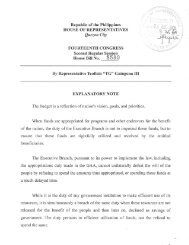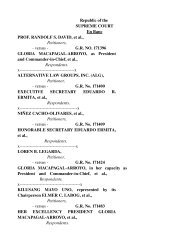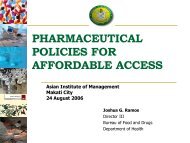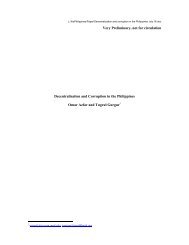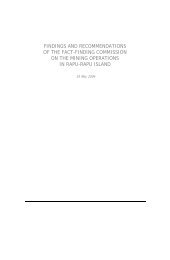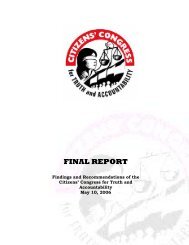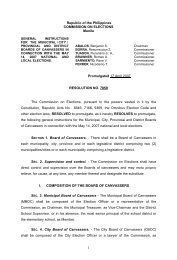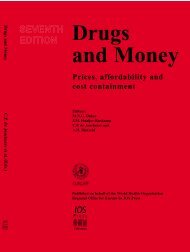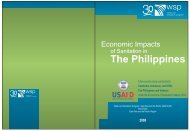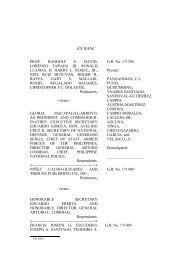The state of water resources in the Philippines - Greenpeace
The state of water resources in the Philippines - Greenpeace
The state of water resources in the Philippines - Greenpeace
You also want an ePaper? Increase the reach of your titles
YUMPU automatically turns print PDFs into web optimized ePapers that Google loves.
II. Quality <strong>of</strong> <strong>water</strong> <strong>resources</strong><br />
<strong>The</strong> Philipp<strong>in</strong>e Clean Water Act <strong>of</strong> 2004 def<strong>in</strong>es <strong>water</strong> quality as <strong>the</strong><br />
characteristics <strong>of</strong> <strong>water</strong> that def<strong>in</strong>e its use and measured <strong>in</strong> terms <strong>of</strong> physical,<br />
chemical, biological, bacteriological, or radiological characteristics by which <strong>the</strong><br />
acceptability <strong>of</strong> <strong>water</strong> is evaluated, to classify <strong>water</strong> <strong>resources</strong> and <strong>the</strong>ir beneficial<br />
use.<br />
A number <strong>of</strong> ambient standards for measur<strong>in</strong>g <strong>water</strong> quality have been<br />
formulated by <strong>the</strong> Department <strong>of</strong> Environment and Natural Resources (DENR).<br />
DAO 34, issued <strong>in</strong> 1990, <strong>in</strong>cludes classifications for both surface and coastal<br />
<strong>water</strong>. For each classification, current beneficial use (e.g., dr<strong>in</strong>k<strong>in</strong>g <strong>water</strong>, etc.) is<br />
given. It also conta<strong>in</strong>s <strong>water</strong> quality criteria for each class appropriate to <strong>the</strong><br />
designated beneficial use.<br />
Accord<strong>in</strong>g to EMB, under this DAO, 33 parameters def<strong>in</strong>e <strong>the</strong> desired <strong>water</strong><br />
quality per <strong>water</strong> body classification. However, <strong>in</strong> <strong>the</strong> absence <strong>of</strong> a <strong>water</strong> quality<br />
<strong>in</strong>dex, EMB also mentioned that certa<strong>in</strong> parameters may be used <strong>in</strong> <strong>the</strong> <strong>in</strong>terim.<br />
<strong>The</strong>se parameters <strong>in</strong>clude:<br />
• dissolved Oxygen (DO), Biochemical Oxygen Demand (BOD), Total<br />
Suspended Solids (TSS), Total Dissolved Solids (TDS), and heavy metals<br />
for <strong>in</strong>land surface <strong>water</strong>s; and<br />
• fecal coliform, nitrates, and sal<strong>in</strong>ity (chloride content) for ground<strong>water</strong> as<br />
def<strong>in</strong>ed <strong>in</strong> <strong>the</strong> Philipp<strong>in</strong>e National Standards for Dr<strong>in</strong>k<strong>in</strong>g Water (PNSDW).<br />
While sal<strong>in</strong>ity is not directly related to pollution, it is also used as a common<br />
parameter for ground<strong>water</strong> quality assessment to measure <strong>the</strong> level <strong>of</strong><br />
contam<strong>in</strong>ation from sal<strong>in</strong>e <strong>water</strong>.<br />
Water quality criteria def<strong>in</strong>ed <strong>in</strong> each <strong>of</strong> <strong>the</strong>se parameters serve as benchmark<br />
aga<strong>in</strong>st which monitor<strong>in</strong>g data are compared to assess <strong>the</strong> quality <strong>of</strong> <strong>water</strong><br />
bodies based on established classifications (EMB, 2005).<br />
A. Water quality classification (for surface <strong>water</strong>s)<br />
Data from <strong>the</strong> EMB show that as <strong>of</strong> 2005, it has classified 525 <strong>water</strong> bodies <strong>in</strong><br />
terms <strong>of</strong> best usage and <strong>water</strong> quality, represent<strong>in</strong>g 62.5 percent <strong>of</strong> <strong>the</strong><br />
<strong>in</strong>ventoried <strong>water</strong> bodies <strong>in</strong> <strong>the</strong> country. Of <strong>the</strong>se <strong>water</strong> bodies, 263 are pr<strong>in</strong>cipal<br />
rivers, 213 are m<strong>in</strong>or rivers, seven are lakes, and 42 are coastal and mar<strong>in</strong>e<br />
<strong>water</strong>s.<br />
Of <strong>the</strong> classified <strong>in</strong>land surface <strong>water</strong> bodies, five are Class AA, 203 are<br />
classified as Class A, 149 are Class B, 231 are Class C, and 23 are Class D.<br />
Table 2 presents this breakdown <strong>of</strong> classified <strong>in</strong>land surface <strong>water</strong> bodies <strong>in</strong> <strong>the</strong><br />
country. Of <strong>the</strong> 525 <strong>water</strong> bodies, 133 have dist<strong>in</strong>ct classification based on <strong>the</strong>ir<br />
upstream, midstream, and downstream sections, hence, <strong>the</strong> total number <strong>of</strong><br />
classifications made reach 611.<br />
GREENPEACE | <strong>The</strong> <strong>state</strong> <strong>of</strong> <strong>water</strong> <strong>in</strong> <strong>the</strong> Philipp<strong>in</strong>es 13



